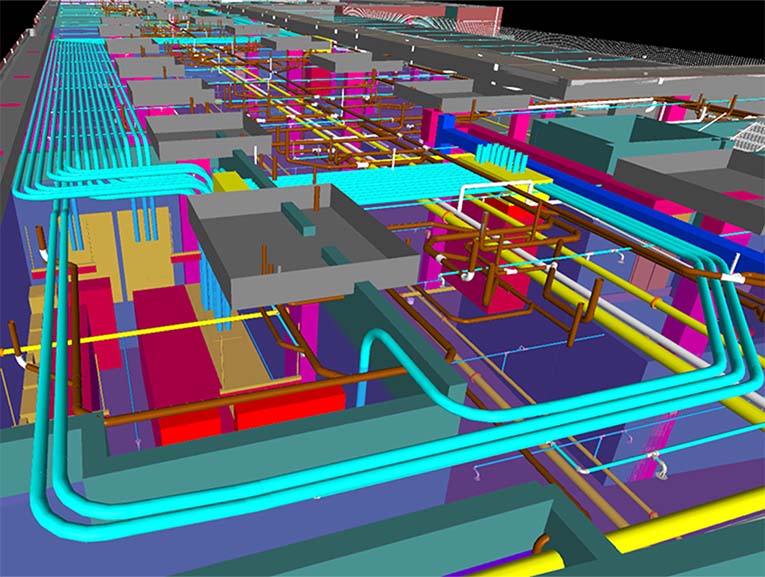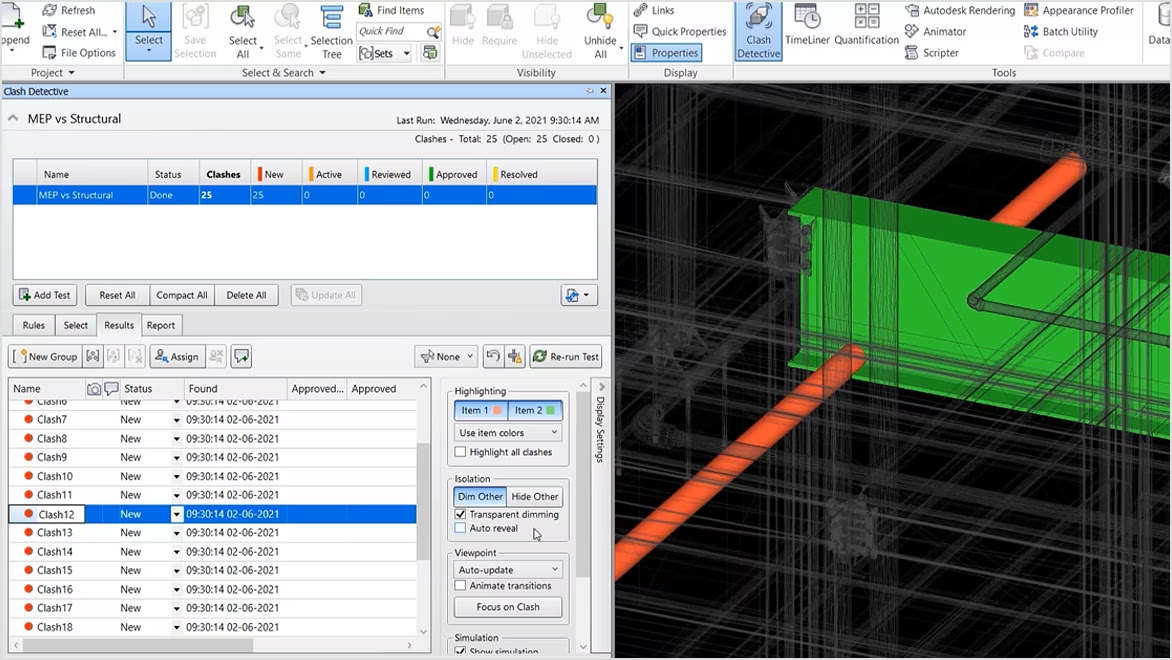
Building Information Modelling (BIM) is transforming the electrical engineering industry by offering a collaborative and data-rich environment for design, construction, and facility management. With the rise of smart buildings and complex electrical systems, the need for BIM for electrical engineering has never been greater. Traditional design processes often led to errors, cost overruns, and inefficient coordination among project stakeholders. However, MEP BIM modelling enables electrical engineers to create accurate, clash-free, and optimised designs for electrical infrastructure.
Traditionally, electrical engineers relied on 2D schematics and separate documentation for design and implementation. However, this approach often led to miscommunication, errors, and inefficiencies. BIM modelling software enables electrical engineers to create a 3D digital representation of electrical components within a building, ensuring greater accuracy and seamless integration with other disciplines such as mechanical and plumbing systems
What is BIM for Electrical Engineers?

BIM for electrical engineering is a game-changing approach that integrates electrical system design into a centralised digital environment. Unlike traditional 2D design methods, BIM electrical engineers use intelligent 3D models to plan, design, analyse, and manage electrical components in a building. These models provide a data-rich representation of electrical layouts, allowing engineers to optimise circuits, prevent clashes, and improve overall efficiency.
With the growing complexity of electrical infrastructure, BIM electrical engineers play a crucial role in ensuring precise coordination between different disciplines, including mechanical and plumbing systems (MEP in BIM). Engineers can enhance collaboration, reduce errors, and streamline workflows across all project stages by using BIM-related software.
BIM’s Role in Electrical System Design
BIM electrical engineers leverage BIM MEP software to design comprehensive electrical systems, including:
- Power Distribution Networks: Helps in mapping out switchboards, transformers, and panel boards.
- Lighting Design: Simulates and analyses lighting layouts for optimal performance.
- Cable Management & Routing: Ensures efficient conduit and cable tray placements to prevent conflicts with structural and mechanical components.
- Fire Alarm & Security Systems: Assists in the accurate positioning of safety devices.
- Renewable Energy Integration: Incorporates solar panels, wind turbines, and battery storage systems into the electrical infrastructure.
Why Electrical Engineers Should Adopt BIM?

As the construction industry advances toward digitalisation, BIM for electrical engineering has become a crucial tool for enhancing project efficiency, accuracy, and collaboration. Traditional electrical system design relied heavily on 2D schematics, which often led to errors, miscommunication, and costly rework. However, with BIM software, electrical engineers can transition to intelligent 3D models that provide better visualisation, analysis, and coordination.
In an era where smart buildings, automation, and energy efficiency are top priorities, BIM electrical engineers play a vital role in ensuring optimal electrical infrastructure design. The ability to integrate electrical systems seamlessly with mechanical and plumbing components (MEP in BIM) enhances project outcomes, making BIM for electrical engineering indispensable for modern construction projects.
The adoption of BIM for electrical engineering offers several advantages:
- Improved Accuracy: BIM software enables precise modelling of electrical components, reducing rework and errors.
- Enhanced Collaboration: A centralised model allows architects, mechanical engineers, and electrical engineers to work seamlessly together.
- Efficient Design Optimisation: BIM electrical engineers can analyse energy consumption, circuit loads, and lighting requirements in real time.
- Cost and Time Savings: Detecting clashes early minimises costly rework and accelerates project completion.
- Regulatory Compliance: Automated validation ensures compliance with electrical codes and standards.
- Sustainability: BIM modelling software aids in designing energy-efficient electrical systems, supporting green building initiatives.
Key Applications of BIM in Electrical Engineering
The adoption of BIM for electrical engineering has transformed the way electrical systems are designed, analysed, and implemented in modern construction projects. Unlike traditional design methods, BIM software allows electrical engineers to create intelligent 3D models that integrate seamlessly with mechanical and plumbing systems (MEP in BIM). This digital approach enhances accuracy, collaboration, and efficiency, making BIM electrical engineers indispensable in today’s construction industry.
From power distribution to energy management, BIM modelling software provides electrical engineers with advanced tools to optimise electrical infrastructure. The use of BIM-related software ensures that engineers can streamline workflows, reduce errors, and enhance project outcomes. Below are some of the key applications of BIM for electrical engineering that demonstrate its significance in the industry.
BIM for electrical engineering finds applications across multiple aspects of design and construction:
- Power Distribution Planning: Ensures optimal layout and connectivity of electrical networks.
- Lighting Design and Analysis: Simulates lighting conditions to enhance efficiency and occupant comfort.
- Cable Management and Routing: Prevents clashes with structural and mechanical components.
- Fire Alarm and Security Systems: Facilitates the strategic placement of safety devices.
- Facility Management and Maintenance: Assists in asset tracking and lifecycle management.
Top BIM Software for Electrical Engineers
The adoption of BIM for electrical engineering has significantly transformed the way electrical systems are designed and implemented in modern construction. As the industry moves towards smarter, more efficient workflows, using the right BIM software is crucial for BIM electrical engineers to enhance accuracy, collaboration, and project efficiency.
With numerous BIM-related software options available, electrical engineers must choose tools that align with their project requirements. From BIM MEP software for designing complex electrical layouts to BIM modelling software for seamless coordination with other disciplines, the right technology can streamline workflows and improve project outcomes. Below, we explore the top BIM software that electrical engineers should consider for effective MEP in BIM workflows.
To fully leverage BIM for electrical engineering, professionals must master leading BIM-related software, including:
- Revit MEP: The most widely used BIM MEP software, enabling detailed MEP BIM modelling and clash detection.
- AutoCAD MEP: Facilitates 2D and 3D BIM electrical engineer workflows with automation capabilities.
- Navisworks: Allows clash detection and project coordination among multiple disciplines.
- ETAP: Specialised in electrical power system analysis using BIM software.
- Dialux: Used for advanced lighting analysis and energy efficiency planning.
Proficiency in these tools enhances career prospects and job opportunities for BIM electrical engineers.
Challenges in BIM Adoption for Electrical Engineers & How to Overcome Them
Despite its benefits, adopting BIM for electrical engineering presents challenges:
- High Initial Investment: Advanced BIM-related software requires financial investment in tools and training.
- Steep Learning Curve: Mastering BIM modelling software demands time and effort.
- Resistance to Change: Traditional design teams may be hesitant to transition to BIM software.
- Data Management Complexity: Handling large BIM datasets requires robust computing resources.
How to Overcome These Challenges:
- Invest in Training: Enrolling in professional courses enhances BIM electrical engineer skills.
- Gradual Implementation: Start with small projects before scaling up.
- Leverage Cloud-Based BIM: Utilise collaborative platforms for efficient project coordination.
Career Opportunities & Salary Trends for BIM-Enabled Electrical Engineers
The demand for BIM electrical engineer jobs is increasing globally, with lucrative opportunities across construction, infrastructure, and smart city projects. A BIM electrical engineer job description typically includes responsibilities such as MEP BIM modelling, clash detection, and coordination with other disciplines.
BIM Electrical Engineer Salary Trends
- In the UK, the average BIM electrical engineer salary ranges between £35,000 and £55,000 annually, depending on experience and expertise.
- In the US, salaries can exceed $80,000 for experienced professionals.
- Emerging markets, including India and the Middle East, are witnessing a rise in electrical engineering jobs that require proficiency in BIM software.
How Novatr’s BIM Courses Can Help Electrical Engineers Excel in BIM Workflows
The increasing demand for BIM for electrical engineering has made it essential for electrical engineers to upskill and stay competitive in the industry. As construction projects become more complex, mastering BIM software and BIM-related software has become a crucial requirement for BIM electrical engineers. Professionals with expertise in BIM MEP software are better equipped to handle MEP BIM modelling, improve project efficiency, and secure better job opportunities in BIM electrical engineer jobs.
For those looking to upskill, Novatr offers industry-relevant courses that specialise in BIM for electrical engineering. Their courses provide:
1. Hands-On Training with Advanced BIM Tools
Learn through real-world applications using industry-leading BIM MEP software, including Revit MEP, AutoCAD MEP, and Navisworks.
2. Industry-Recognised Certification
Stand out in the job market with a certification that validates expertise in BIM for electrical engineering.
3. Expert-Led Instruction
Gain insights from experienced BIM electrical engineers and industry professionals, ensuring practical and relevant learning.
4. Real-World Projects and Case Studies
Work on real-life MEP in BIM projects to develop problem-solving skills and technical proficiency.
5. Career Guidance and Job Assistance
Get access to mentorship, resume-building support, and job placement assistance to secure top BIM electrical engineer jobs.
Conclusion
Integrating BIM for electrical engineering is revolutionising the industry by improving accuracy, efficiency, and collaboration. Electrical engineers skilled in BIM MEP software are highly sought after in the job market. Overcoming adoption challenges through professional training and leveraging leading BIM software can unlock career growth and lucrative opportunities in the field. As the demand for BIM electrical engineers continues to rise, investing in BIM modelling software proficiency is the key to securing high-paying roles in electrical engineering jobs.
Whether you are an aspiring professional or an experienced engineer, mastering MEP in BIM can elevate your career to new heights. Among the best options, the BIM Professional Program for MEP Engineers by Novatr stands out the most. For the latest updates, tools, and insights into the MEP and BIM industry, explore Novatr's Resource Page.
FAQs
Q1: Why should electrical engineers adopt BIM in their projects?
Ans: Electrical engineers should adopt BIM for electrical engineering to enhance project efficiency, reduce design errors, and improve collaboration with other disciplines. BIM modelling software enables accurate planning of electrical systems, minimizing clashes and rework. Additionally, MEP in BIM workflows allow better integration of electrical, mechanical, and plumbing systems, ensuring seamless project execution.
Q2: What are the key benefits of BIM for electrical engineers?
Ans: The benefits of BIM for electrical engineers include improved design accuracy, enhanced coordination with architects and structural engineers, and better visualization of electrical layouts. BIM electrical engineers can optimize material usage, reduce costs, and streamline maintenance workflows. Moreover, adopting BIM software leads to increased efficiency and faster project completion with minimal errors.
Q3: Which BIM software tools are commonly used by electrical engineers?
Ans: Electrical engineers frequently use BIM MEP software such as Revit MEP, AutoCAD MEP, and Navisworks for MEP BIM modelling and system analysis. These BIM-related software tools help in designing, simulating, and optimizing electrical networks. Other BIM modelling software like Bentley OpenBuildings and Trimble SysQue also enhance precision and coordination in electrical engineering projects.
Q4: What are the career opportunities for electrical engineers with BIM expertise?
Ans: Electrical engineers proficient in BIM for electrical engineering can secure top roles such as BIM electrical engineer, MEP design specialist, and BIM coordinator. The demand for BIM electrical engineer jobs is increasing in construction, infrastructure, and smart building projects. Additionally, BIM expertise improves earning potential, with a competitive BIM electrical engineer salary worldwide.
Q5: How does BIM improve electrical system design and coordination?
Ans: BIM software enhances electrical system design by providing a 3D collaborative environment, allowing precise modeling and early clash detection. MEP in BIM enables seamless coordination between electrical, mechanical, and plumbing systems, reducing project delays and conflicts. With BIM-related software, engineers can achieve better planning, energy efficiency, and operational performance in electrical infrastructure.
Was this content helpful to you



.jpeg)



